Our way through the thorns to the stars. The history of past greatness and dreams of the future ...
The last time on the Web increased fermentation around space exploration. And this is understandable, then new solar cells were invented there, with surprising efficiency, here microsatellites were standardized and Arduino was launched into space, then this and that. And when Curiosity successfully primarilsya and began to transmit images, here God himself ordered the public to explode in discussions.
And it is natural, already overdue, so to speak. It hurts too much time passed from the flight of the first satellite, the first man and the landing on the moon. And things, as they say, and now there. Radically new in the space industry, nothing happened, no loud breakthroughs, only improvements and improvements ... Hence the heightened interest in the topic, people feel that the time has come for new accomplishments.
Further I ask under kat, there will be a lot of emotions and photos.
... And I feel it. And looking at 10 foreign successes, we have one domestic, and how one of our failures accounts for up to five of ours ... and how all this is then exaggerated with gusto in the media, and how Roscosmos, enterprises, science, scientists ... and people ... And what a sin to conceal, I myself often scold Roscosmos. Well, there is simply no more strength, well, how much can you roll down.
To roll down from year to year, when we already had everything. We were the first, and sought further not only because we were obliged to be the first. And because we so wanted, we needed it, we needed stars! And we were ready to give them to everyone. We sought them and called for the rest. And they were happy and purposeful in their zeal.
And when I once again blinked our Roskosmos, then with sorrow I caught myself thinking that we all remember the past greatness, but we don’t have a common memory bank of our achievements. And this is amazing! Much with great pleasure, people prepare lists of our space failures, build beautiful graphics and carefully compare with competitors in order to then shake their heads meaningfully and sigh "Yeah ... everyone pissed off ...".
But this is wrong. After all, these snot lead to nothing!
')
But let's remember better than we are rich. Let's look at our achievements , all at once, comprehensively.
Everyone has a memory of some achievement from the past, but they are all scattered, in the media, on the web, between people. I propose to combine them. To isolate from the general course of events and show separately from the list of our failures.
I am sure that the result will be directly opposite to the one that causes a simple comparison of our achievements and them, our failures and them, which is so popular now, which is in trend, so to speak.
And yes, you guessed it, the post will be devoted to the popularization of astronautics in our homeland.
I invite you to look at the achievements in the space industry of a single enterprise - VNIITRANSMASHA.
And only a narrow slice of advances in the development of planetary rovers.
And I assure you that in such a view you will have a different look at our national science, and its past, and its future.
I took the Chronology of Space Development available on the VNIITRANSMASHA website. But according to the author’s strange idea, it’s impossible to get to this page from the site of the enterprise itself. I once managed to reach it only by reference from a search engine ... you must admit, the creator’s non-trivial approach.
Then I tried to fill the material with good photos and the maximum number of links, revealing the importance of each individual development. It is possible to be or not to be a visual, but we get 90% of the information through sight.
And although it was not possible to find additional information or photographs for all products ( modern time mercilessly erases from memory everything that does not have an equivalent in gross profit, including people ... ), in my opinion it turned out very well.
The main thing is that I solved the main task I had set myself - I made one cell of our achievements bank (forgive me for pride and pomposity), a small cell limited only by rover and only one enterprise, but the CELLULAR.
Let not very professional in terms of web designer, and not very correct in terms of links to foreign articles and resources. But I am satisfied with my work. In my heart, an article causes exactly the feeling that I wanted to feel - pride, the power of opportunity and the desire to go forward.
And who decides to improve my thought (for I will regard any constructive criticism as an improvement), so I will only be happy, so the topic has found its reader and I chose the right way))
So:
The Luna-13 spacecraft made a soft landing on the surface of the moon with instruments for determining the properties of the ground.
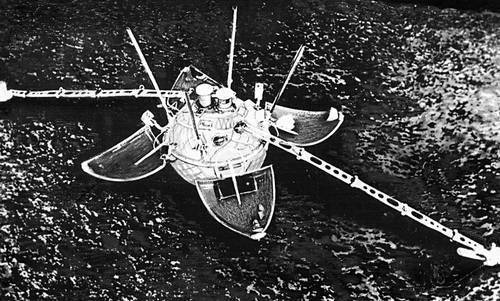
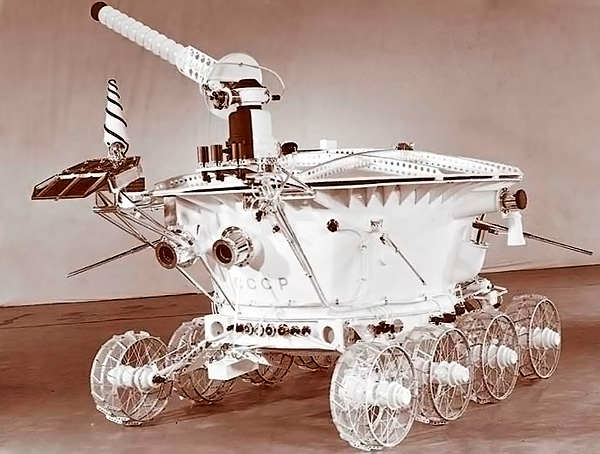
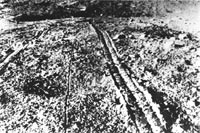
The PROP-M mini-mars rover with a penetrometer was designed and installed at the Mars-3 , -6 space stations to study the properties of the Mars soil, delivered to the Mars surface and a short communication session was performed.

A mobile unit PROP-F was designed and installed on board the Phobos-2 station to study the properties of the surface of Phobos. Communication with the space station Phobos-2 was lost in the near Marse space.

Created on the basis of the chassis "Lunokhod-1" experienced articulated chassis of the Lunokhod with enhanced characteristics.
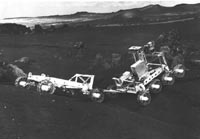
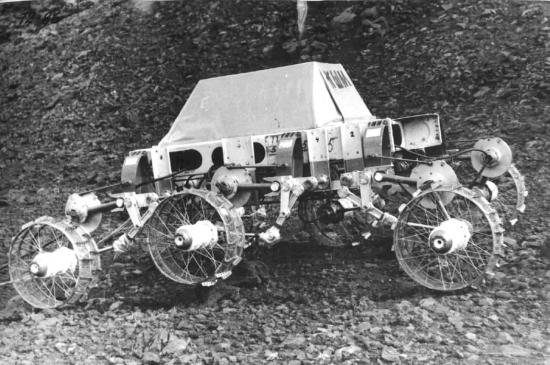

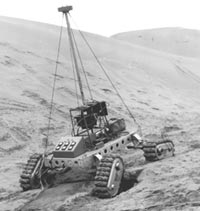


A chassis layout of the XM-KPP with a 6 × 6 wheel formula and an onboard turn for the development of technical solutions for the rover for astronauts has been created. Weight 240 kg. Driving speed 0.51 or 5.1 km / h. Cracked cracks 0.6 m, lifting angle on loose soil 24 °, individual stones 0.5 m high, step 0.4 m.

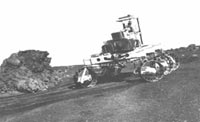
The PROP-V penetrometer was designed and delivered on March 1 to the surface of Venus. Measurements of the bearing capacity, the resistance of the rotational section of the stamp and the electrical resistance of the soil were made.



Work began on a mobile penetrometer capable of penetrating to the ground to a greater depth (tens of meters) and returning to the surface. It was planned to place scientific instruments in the case of the penetrometer to study the properties of the soil.

A specialized transporter robot STR-1 was created to clean the roof of the 3rd unit of the Chernobyl NPP .
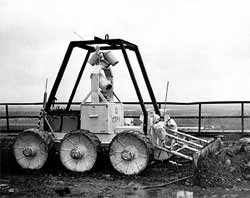


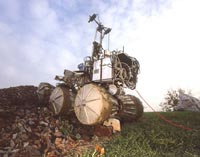
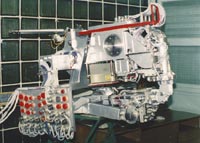

An on-board manipulator was manufactured by request of the European Space Agency's Technical Center (ESA / ESTEC) for the LRMC lunar rover demonstrator.

A 2-axis precision targeting platform Orientator was created for the Mir orbital station. The mass of the platform is 85 kg, the mass of scientific equipment is 112 kg. The flight model was delivered by the Progress cargo ship aboard the Mir station.
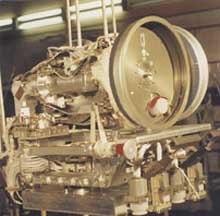


A set of drives for deployment of the power ring of a large deployable space antenna has been manufactured.
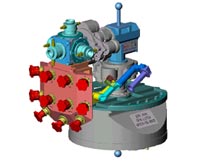
Unfortunately, after 2004, I did not find in the media at least some detailed references to new developments and simply about the activities of VNIITM.
Nevertheless, running only a narrow slice of the space development of oneSoviet Russian enterprise, my heart overflows with pride in the former greatness of our science, both applied and theoretical. And we had everything - the possibilities and the desire.
And it seems to me that the time has come to finally sober up from the 20-year-old dope of the market economy and take a step BACK, for there is nowhere to step forward after the ideology of “bought cheaper - sold more expensive”, there is a bottomless abyss and silence ...
Take a step where people were ruled by ideas and a fiery heart, not a consumer basket and fear.
But do not confuse my call with the call to return to the communist past, I’m not talking about it at all, and not even about the political system in principle, because the ideal system on Earth does not exist now and will not exist until monetary relations are higher than social and spiritual. I urge you to carefully read at least the last hundred years. We have already tried all the rakes and in all poses in which it is only possible to do this with a rake. And we already have more than enough baggage of experience and knowledge to finally start living and working in a Human way, to be happy, and to make happy people around us ...
And as a modest contribution to the excursion into the past, links to additional resources (some have already been used in this article as sources of good photos) for this very narrow (almost through the eyes of a single enterprise), but very interesting and significant topic, the topic of space research.
A man always looked at the stars, and sometimes he did it more than well:
In conclusion, I repeat once again, now we are rolling down. And not by their own will, but by their lack of will.
But we already had everything, and we have everything to go up. And this main “all” is our people.
This is us.
PS
If anyone has good comprehensive links to the achievements of the domestic space industry, in any language, please send a good addition to the list.
And it is natural, already overdue, so to speak. It hurts too much time passed from the flight of the first satellite, the first man and the landing on the moon. And things, as they say, and now there. Radically new in the space industry, nothing happened, no loud breakthroughs, only improvements and improvements ... Hence the heightened interest in the topic, people feel that the time has come for new accomplishments.
Further I ask under kat, there will be a lot of emotions and photos.
... And I feel it. And looking at 10 foreign successes, we have one domestic, and how one of our failures accounts for up to five of ours ... and how all this is then exaggerated with gusto in the media, and how Roscosmos, enterprises, science, scientists ... and people ... And what a sin to conceal, I myself often scold Roscosmos. Well, there is simply no more strength, well, how much can you roll down.
To roll down from year to year, when we already had everything. We were the first, and sought further not only because we were obliged to be the first. And because we so wanted, we needed it, we needed stars! And we were ready to give them to everyone. We sought them and called for the rest. And they were happy and purposeful in their zeal.
And when I once again blinked our Roskosmos, then with sorrow I caught myself thinking that we all remember the past greatness, but we don’t have a common memory bank of our achievements. And this is amazing! Much with great pleasure, people prepare lists of our space failures, build beautiful graphics and carefully compare with competitors in order to then shake their heads meaningfully and sigh "Yeah ... everyone pissed off ...".
But this is wrong. After all, these snot lead to nothing!
')
But let's remember better than we are rich. Let's look at our achievements , all at once, comprehensively.
Everyone has a memory of some achievement from the past, but they are all scattered, in the media, on the web, between people. I propose to combine them. To isolate from the general course of events and show separately from the list of our failures.
I am sure that the result will be directly opposite to the one that causes a simple comparison of our achievements and them, our failures and them, which is so popular now, which is in trend, so to speak.
And yes, you guessed it, the post will be devoted to the popularization of astronautics in our homeland.
I invite you to look at the achievements in the space industry of a single enterprise - VNIITRANSMASHA.
And only a narrow slice of advances in the development of planetary rovers.
And I assure you that in such a view you will have a different look at our national science, and its past, and its future.
I took the Chronology of Space Development available on the VNIITRANSMASHA website. But according to the author’s strange idea, it’s impossible to get to this page from the site of the enterprise itself. I once managed to reach it only by reference from a search engine ... you must admit, the creator’s non-trivial approach.
Then I tried to fill the material with good photos and the maximum number of links, revealing the importance of each individual development. It is possible to be or not to be a visual, but we get 90% of the information through sight.
And although it was not possible to find additional information or photographs for all products ( modern time mercilessly erases from memory everything that does not have an equivalent in gross profit, including people ... ), in my opinion it turned out very well.
The main thing is that I solved the main task I had set myself - I made one cell of our achievements bank (forgive me for pride and pomposity), a small cell limited only by rover and only one enterprise, but the CELLULAR.
Let not very professional in terms of web designer, and not very correct in terms of links to foreign articles and resources. But I am satisfied with my work. In my heart, an article causes exactly the feeling that I wanted to feel - pride, the power of opportunity and the desire to go forward.
And who decides to improve my thought (for I will regard any constructive criticism as an improvement), so I will only be happy, so the topic has found its reader and I chose the right way))
So:
Chronology of space research VNIITM
- 1963. Commencement of work on the study of the possibility of creating a chassis of a moon rover.
- 1964. The beginning of work on the creation of an automatic chassis of the lunar rover.
- 1966. The orbital tests of the reducers were carried out on the Luna -10, -11 spacecraft (SC).
The Luna-13 spacecraft made a soft landing on the surface of the moon with instruments for determining the properties of the ground.

- 1968. The first flight model of the moon rover was handed over to the customer.

- 1970 On November 10, the space station was successfully launched with Lunokhod-1. After a soft landing of the station "Luna-17" in the Sea of Rains on November 17 at 7 h. 20 min. "Lunokhod-1" descended on the ramps of the spacecraft to the surface of the moon.
- 1971. On September 30, Lunokhod-1 ceased operation due to the development of the resource of the isotope heat source of the thermal control system. "Lunokhod-1" was on the lunar soil of 10.5 km. Made 530 measurements of the characteristics of the soil.

The PROP-M mini-mars rover with a penetrometer was designed and installed at the Mars-3 , -6 space stations to study the properties of the Mars soil, delivered to the Mars surface and a short communication session was performed.

A mobile unit PROP-F was designed and installed on board the Phobos-2 station to study the properties of the surface of Phobos. Communication with the space station Phobos-2 was lost in the near Marse space.

Created on the basis of the chassis "Lunokhod-1" experienced articulated chassis of the Lunokhod with enhanced characteristics.

- 1972 Created a KSHM mockup with a wheel-walking propeller . Weight 320 kg. The base is 1.7 ... 2.2 m. The travel speed is 0.9 or 0.15 km / h (walking mode). Overcoming rise 18 ° or 34 ° (in walking mode).

- 1973 On January 16, the Lunokhod-2 was delivered to the lunar surface by the station “Luna-21”, which worked until 4 June 1973, covered 30.5 km, carried out 490 measurements of the soil characteristics.

- 1974 Created a 4GM undercarriage model with tracked propulsion. Weight 250 ... 350 kg. Driving speed 1 or 2 km / h.

- 1975 A model with a ski-walking propeller for movement on pulverized soil with a low bearing capacity was created. Weight 240 kg. The ground pressure is 0.3 or 0.1 N / cm2.

- 1978 A 6-wheel mockup of the EO SAS was created for testing the wheel-walking propeller and the automatic control system of promising rover. Weight 480 kg. The movement speed is 0.3 or 0.02 (in walking mode) km / h. Ensured increased permeability and resistance from tipping, the ability to control roll, trim, ground clearance, etc.

A chassis layout of the XM-KPP with a 6 × 6 wheel formula and an onboard turn for the development of technical solutions for the rover for astronauts has been created. Weight 240 kg. Driving speed 0.51 or 5.1 km / h. Cracked cracks 0.6 m, lifting angle on loose soil 24 °, individual stones 0.5 m high, step 0.4 m.

- 1981 Created undercarriage model HM-PC with swivel wheels to increase the maneuverability of the chassis of the rover in difficult relief conditions. Weight 320 kg. Driving speed 0.9 km / h. The angle of rotation of the wheels ± 45 °.

- 1983 The Institute begins to develop a system for securing and deploying the Buran orbital vehicle onboard manipulator.
The PROP-V penetrometer was designed and delivered on March 1 to the surface of Venus. Measurements of the bearing capacity, the resistance of the rotational section of the stamp and the electrical resistance of the soil were made.

- 1984 Created a 6-wheeled chassis layout HM-VD for long-term work on Venus using the energy of wind flows.

- 1985 A 6-legged walking model of the NMSHA was created for testing the design of the walking propulsion and control system. Weight 750 kg. Movement speed 0.7 km / h, lifting capacity 50 kg, ground clearance 1.5 m.

- 1986 The XM-VD2 undercarriage model was created with one rotary wind turbine for recharging the battery - the main source of energy for the motor wheels.
Work began on a mobile penetrometer capable of penetrating to the ground to a greater depth (tens of meters) and returning to the surface. It was planned to place scientific instruments in the case of the penetrometer to study the properties of the soil.

A specialized transporter robot STR-1 was created to clean the roof of the 3rd unit of the Chernobyl NPP .

- 1988 Created a “Mir” undercarriage model with a hinged frame and beskirerensny wheel-walking propulsion. Overcoming with 34 ° loose soil, 1 m overhang. Equipped with an automatic device for detecting dangerous obstacles, avoiding them according to a predetermined algorithm and going to a given point of the intended route.

- 1989 Carried out running tests of a mover model with inflatable wheels of large diameter (1.28 m). Weight 95 kg, base 1.6 m, tire pressure 0.4 ... 1.0 kgf / cm2. Overcoming lift with loose soil 33 °, ledge 0.6 m. The speed of movement is 0.15 ... 0.9 km / h.
- 1991–1992. A mock-up of the small rover was created and tested in conjunction with the ICI and NPLs in Kamchatka and in the Mohavi desert (USA).
- 1994 Two versions of the 3- section microrobot demonstration model were created and transferred to the Max Planck Institute of Chemistry (Germany). Overall dimensions 200 × 200 × 50 mm, weight 1.5 kg. Overcoming the rise on loose sand 29 °, crack or ledge 250 ... 300 mm.

- 1995 Designed, manufactured and delivered self-propelled ground landing gear demonstrator of the rover according to the LAMA project. Weight 165 kg. The payload is 90 kg, the speed is 0.06 ... 0.18 m / s. Gradeability on loose ground 25 °, ledge 0.5 m. Travel time on batteries 3.5 hours.

- 1996 The flight model of the 3-axis stabilized platform “Argus” was made for the installation of scientific equipment, the task of which was high-precision imaging of the surface of Mars. The platform was installed on the Mars spacecraft.

- 1996, 1998 Two self-propelled automatic chassis of a planetary rover demonstrator with control systems for individual teams (1996) and for a given trajectory and virtual remote control (1998) were developed, manufactured and supplied by CNES. The chassis has a weight of 150 kg. Overcoming crack 0.8 m, ledge 0.5 m. The wheels are equipped with individual mechanisms of rotation.

An on-board manipulator was manufactured by request of the European Space Agency's Technical Center (ESA / ESTEC) for the LRMC lunar rover demonstrator.
- 1997 Designed and manufactured mockup of the LRMC self-propelled moon chassis as part of the European lunar program for the ESA / ESTEC. LRMC has a wheel formula of 4 × 4. All wheels are swiveling, each of them has its own rotation drive. Chassis weight with batteries 120 kg. 60 kg payload.

A 2-axis precision targeting platform Orientator was created for the Mir orbital station. The mass of the platform is 85 kg, the mass of scientific equipment is 112 kg. The flight model was delivered by the Progress cargo ship aboard the Mir station.

- 2003 Designed, manufactured and submitted to the customer (CNES and LAAS, France) running model of an autonomous rover for the project "CO-MARO". Total weight 50 kg. Power consumption during the day is 20 ... 40 W. Wheel formula 6 × 6.


A set of drives for deployment of the power ring of a large deployable space antenna has been manufactured.
- 2004 An electrically acting sample of the 2-axis monitor guidance platform “Monitor”, designed to ensure the operation of a television camera, a lamp and other payloads that require precise targeting in a wide range of angles and holding in a given direction, was made.

Instead of conclusion
Unfortunately, after 2004, I did not find in the media at least some detailed references to new developments and simply about the activities of VNIITM.
Nevertheless, running only a narrow slice of the space development of one
And it seems to me that the time has come to finally sober up from the 20-year-old dope of the market economy and take a step BACK, for there is nowhere to step forward after the ideology of “bought cheaper - sold more expensive”, there is a bottomless abyss and silence ...
Take a step where people were ruled by ideas and a fiery heart, not a consumer basket and fear.
But do not confuse my call with the call to return to the communist past, I’m not talking about it at all, and not even about the political system in principle, because the ideal system on Earth does not exist now and will not exist until monetary relations are higher than social and spiritual. I urge you to carefully read at least the last hundred years. We have already tried all the rakes and in all poses in which it is only possible to do this with a rake. And we already have more than enough baggage of experience and knowledge to finally start living and working in a Human way, to be happy, and to make happy people around us ...
And as a modest contribution to the excursion into the past, links to additional resources (some have already been used in this article as sources of good photos) for this very narrow (almost through the eyes of a single enterprise), but very interesting and significant topic, the topic of space research.
A man always looked at the stars, and sometimes he did it more than well:
- Wheel planetary robots VNIITM;
- Other development VNIITM;
- An alternative list of developments VNIITM with those. characteristics;
- A documentary film about the "Object E-8" ;
- The documentary film “From the Moon Rover to the Mars Rover” (I strongly recommend everyone to watch this very rare film in English, but everything is clear );
Part 1
Part 2 - A separate film about the device from the second part - “Venus X-VD-2” ; ;
- History of the development of Venus by the Soviet Union (in English);
- History of the development of Venus by the Soviet Union (in Spanish);
- A small article in 2012 about the very first Rover on Mars . Thanks to hydralien and his article: " Soviet rovers ";
- And the very "Chronology of the space theme" , which I took as a basis and, as it seems to me, filled with some new meaning, with your permission ...))
In conclusion, I repeat once again, now we are rolling down. And not by their own will, but by their lack of will.
But we already had everything, and we have everything to go up. And this main “all” is our people.
This is us.
PS
If anyone has good comprehensive links to the achievements of the domestic space industry, in any language, please send a good addition to the list.
Source: https://habr.com/ru/post/150169/
All Articles